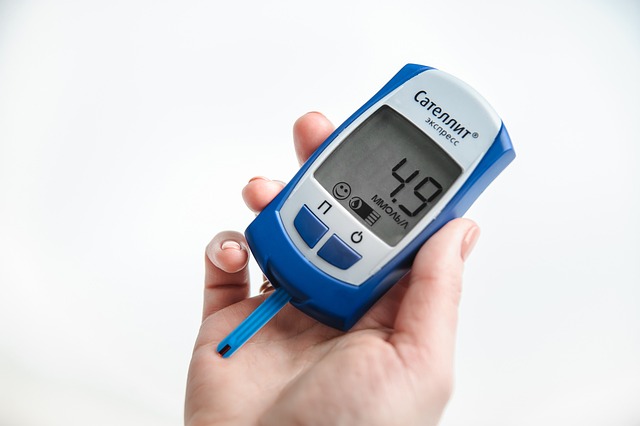Semaglutide, a groundbreaking GLP-1 receptor agonist, revolutionizes type 2 diabetes management by mimicking natural gut responses to meals. It offers significant advantages over traditional treatments with once-weekly long-acting formulations, reducing HbA1c levels and improving weight loss and cardiovascular health. Personalized dosing based on patient characteristics and response is crucial for optimal blood sugar control while minimizing hypoglycemia risks and side effects like nausea. Ongoing research aims to refine dosage strategies, explore dynamic dosing, and combine semaglutide with other interventions for enhanced diabetes care and improved quality of life.
“Unraveling the potential of semaglutide as a revolutionary semaglutide diabetes treatment option, this comprehensive guide explores its role in managing the condition. From its mechanism as a glucagon-like peptide-1 (GLP-1) receptor agonist to its diverse advantages, we delve into the art of dosage optimization.
This article navigates the factors influencing semaglutide dosing, common regimes, and the personalized approach to achieving optimal diabetes control. Additionally, it covers monitoring strategies, potential side effects, and exciting future directions in this burgeoning field.”
Understanding Semaglutide: A Glucagon-Like Peptide-1 Receptor Agonist

Semaglutide is a groundbreaking medication in the diabetes control landscape, offering a novel approach to managing blood sugar levels. It functions as a Glucagon-Like Peptide-1 (GLP-1) receptor agonist, mimicking the natural hormone GLP-1 produced by the gut. This imitation triggers key cellular responses, including insulin secretion when blood glucose is high and suppression of glucagon release, which helps lower blood sugar levels. In the context of diabetes treatment, semaglutide has emerged as a powerful tool due to its unique mechanism of action that differs from traditional insulin therapies.
By activating GLP-1 receptors, semaglutide promotes increased satiety, leading to reduced food intake and subsequent lowering of blood glucose. This dual effect on insulin secretion and glucagon inhibition makes it an effective medication for type 2 diabetes management. The use of semaglutide in diabetes treatment has shown significant improvements in glycemic control, weight loss, and cardiovascular benefits compared to other treatments, making it a promising option for patients seeking better blood sugar regulation.
The Role of Semaglutide in Diabetes Management

Semaglutide, a novel glucagon-like peptide-1 (GLP-1) receptor agonist, has emerged as a potent tool in diabetes management, particularly for individuals with type 2 diabetes. Its role is multifaceted; it aids in blood sugar control by stimulating insulin secretion and suppressing glucagon release, thereby reducing hyperglycemia. This mechanism of action mirrors the natural function of GLP-1, a hormone produced in the gut after meals. Semaglutide’s ability to mimic this effect offers significant advantages in diabetes treatment.
In clinical settings, semaglutide has demonstrated superior efficacy in lowering HbA1c levels compared to other anti-diabetic medications. Its long-acting formulation provides once-weekly administration, enhancing patient convenience and adherence. This not only facilitates better blood sugar control but also reduces the risk of hypoglycemia, making it a preferred choice for many patients. As a game-changer in diabetes treatment, semaglutide offers a promising path towards improved metabolic health and enhanced quality of life for those living with this chronic condition.
Advantages of Using Semaglutide for Diabetes Control

Semaglutide, a novel glucagon-like peptide-1 (GLP-1) receptor agonist, offers several advantages for diabetes control compared to traditional insulin or other antihyperglycemic agents. Its unique mechanism of action not only promotes insulin secretion in a glucose-dependent manner but also reduces appetite and slows gastric emptying, leading to improved glycemic management and weight loss. This dual effect makes semaglutide an attractive option for patients aiming to achieve better blood sugar control while addressing the often-associated burden of excess body weight.
In the context of diabetes treatment, semaglutide has demonstrated superior efficacy in lowering HbA1c levels with once-weekly administration, providing a more convenient dosing regimen than daily injections. Its long-acting nature ensures sustained effects, enabling better glycemic control throughout the week. Additionally, semaglutide has been associated with reduced risks of hypoglycemia and weight gain compared to other medications, making it a game-changer for patients seeking improved diabetes management without compromising their quality of life.
Optimizing Dosage: Factors to Consider

Optimizing dosage for semaglutide diabetes treatment involves a multifaceted approach, as several factors influence its efficacy and safety. Key considerations include patient-specific characteristics such as age, body mass index (BMI), kidney function, and liver health. These factors can impact drug metabolism and excretion, affecting the suitable semaglutide dose for each individual. Additionally, physicians must take into account the severity of diabetes, current blood sugar levels, and any comorbid conditions that might alter medication requirements.
Background therapies, like other medications or insulin regimens, also play a role in determining the optimal semaglutide dosage. Clinical trials have established guidelines for initial dosing, but adjustments are often necessary based on patient response. Regular monitoring of hemoglobin A1c (HbA1c) levels and adverse effects is crucial to fine-tune the dosage, ensuring that blood sugar control is achieved without increasing risks of complications from excessive medication.
Common Dosage Regimes for Semaglutide Therapy

Semaglutide, a novel glucagon-like peptide-1 (GLP-1) receptor agonist, has emerged as a powerful tool in diabetes management, offering both glucose-dependent insulinotropic and weight-reducing effects. The medication is administered via subcutaneous injection and comes in various dosage forms tailored to individual patient needs.
Common dosage regimes include once-weekly and once-daily injections. The starting dose often begins low and is gradually increased over time based on patient response. For example, the initial weekly dose might be 0.25 mg, with increments of 0.25 mg or 0.5 mg every week until the target efficacy is achieved. Once-daily regimens typically involve a fixed starting dose, such as 0.5 mg daily, allowing for easier patient adherence compared to weekly injections. These flexible dosage options cater to different lifestyle and preference considerations in diabetes control with semaglutide therapy.
Personalized Medicine Approach for Semaglutide Dosing

The personalized medicine approach in managing diabetes with semaglutide recognizes that each patient’s response to this medication can vary significantly. This individualized strategy tailors dosing regimens based on specific patient characteristics, aiming for optimal blood sugar control while minimizing adverse effects. By considering factors such as age, body mass index (BMI), and other comorbid conditions, healthcare providers can prescribe the most effective dose of semaglutide for each individual.
This precision medicine approach to semaglutide dosing offers several advantages in diabetes treatment. It ensures that patients receive a personalized therapy aligned with their unique physiological needs, enhancing the likelihood of achieving better glycemic control. Moreover, this tailored strategy may help reduce the time and resources required for dose adjustments, providing patients with more convenient and effective diabetes management.
Monitoring and Adjusting Semaglutide Dosage

The optimal dosage of semaglutide for diabetes control varies from person to person, and regular monitoring is crucial during the treatment process. Healthcare providers often initiate therapy with a low dose, gradually increasing it as needed based on individual responses. Blood sugar levels (HbA1c) are typically measured every 4–6 weeks to assess the effectiveness of semaglutide and adjust the dosage accordingly. This careful navigation ensures that patients receive the most appropriate treatment while minimizing potential side effects.
Effective monitoring involves close collaboration between patients and healthcare teams, who together interpret HbA1c results and decide on any necessary adjustments. Dose optimization may involve either increasing or decreasing semaglutide, depending on whether the current level is successfully managing blood sugar levels or causing adverse reactions. Such proactive management is key to achieving optimal diabetes control with this innovative semaglutide diabetes treatment.
Potential Side Effects and Management Strategies

Semaglutide, as with any diabetes treatment, comes with potential side effects. Some common experiences include nausea, vomiting, and diarrhea, often reported at the start of treatment. These gastrointestinal symptoms usually subside over time. For those persistently affected, dose adjustments or alternative medications can be considered.
Management strategies involve careful monitoring of blood sugar levels to ensure they don’t drop too low (hypoglycemia). Dietary modifications and increased physical activity, alongside semaglutide, can further improve glycemic control. Healthcare professionals should guide patients on recognizing and managing side effects, offering support for a smooth transition and optimal diabetes management.
Future Perspectives on Semaglutide Diabetes Treatment

The future of semaglutide diabetes treatment looks promising, with ongoing research focusing on refining its dosage optimization and understanding its long-term effects. As clinical trials continue to provide valuable insights, healthcare professionals can expect more personalized treatment plans, tailoring semaglutide therapy to individual patient needs. This may involve exploring dynamic dosing regimens, considering factors like meal patterns and physical activity levels, to achieve optimal glucose control while minimizing adverse reactions.
Additionally, the integration of semaglutide into combination therapies is an exciting avenue for exploration. By combining its effects with other diabetes medications or lifestyle interventions, healthcare providers might uncover synergistic benefits, further enhancing glycemic control. Such advancements in semaglutide diabetes treatment have the potential to significantly improve patient outcomes and quality of life for those living with this chronic condition.
